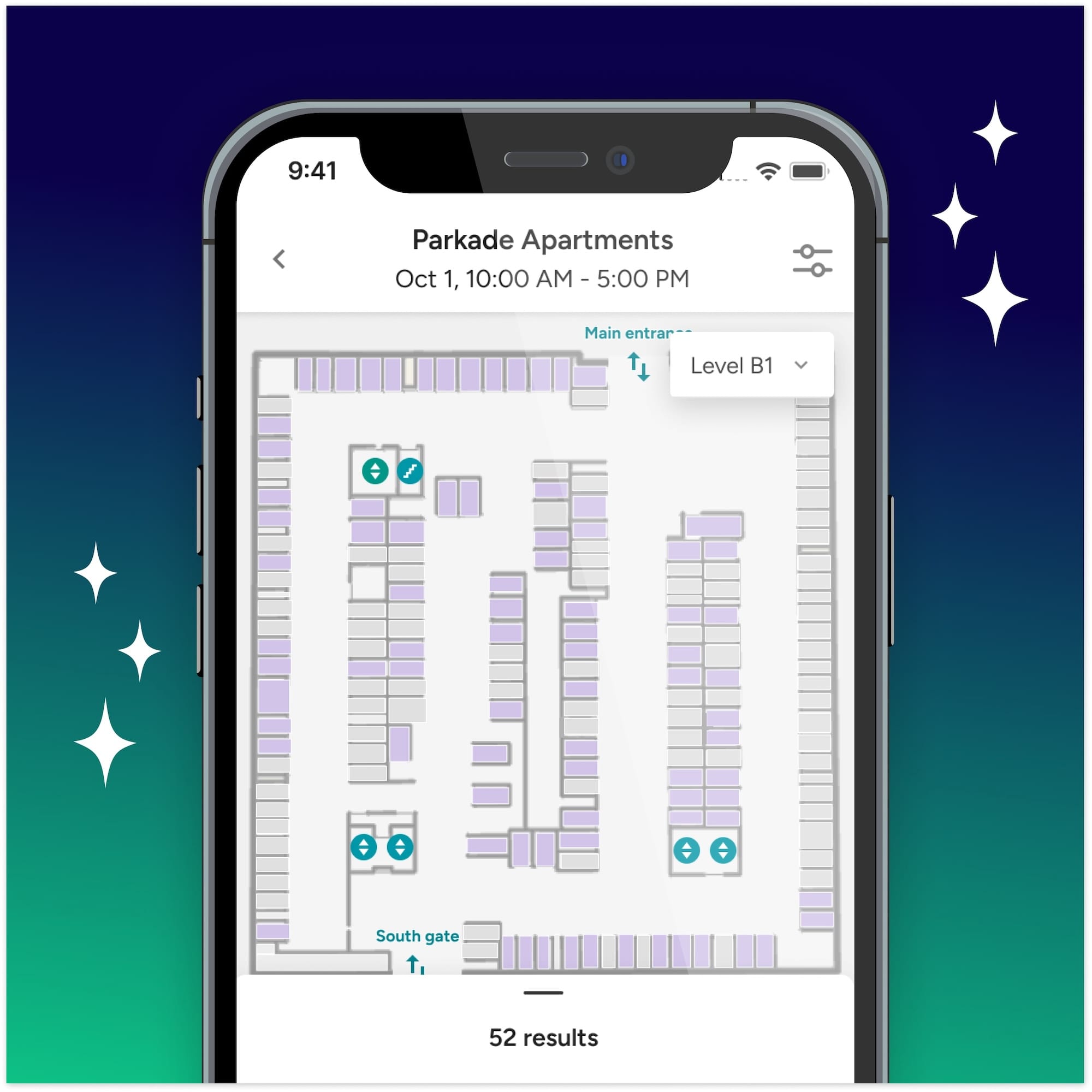

TABLE OF CONTENTS
At Parkade, we work with buildings across the world to help make their parking great. As the world heads toward an EV-centric future, we can help make sure your building is ready for it. Read on to learn more about:
As the world increasingly embraces EVs, access to reliable EV charging will become increasingly non-negotiable for residents at multifamily buildings. Having EV chargers may seem like a luxury amenity right now, but it’s quickly becoming table stakes.
Thanks to increased consumer interest, government policies and buy-in from the auto industry, EVs are here to stay.
“In the US, the total share of new car sales in 2022 hit 5% for EVs,” says Mike Dinucci, Senior Vice President of Sales at Xeal. “And once a country hits that 5% penetration, they tend to snowball toward 50% rapidly. We’ve seen it happen in countries like Japan and Norway.”
“In the first quarter of 2023 alone, the share of new cars purchased in the US that are EVs hit 25%. So the exponential adoption of EVs has already begun,” he adds.
In fact, over 100 million EVs are expected on the roads globally by 2026, and over 700 million by 2040, according to BloombergNEF’s latest annual Long-Term Electric Vehicle Outlook (EVO).
That’s a lot of EVs. And with 75% of EV owners preferring to charge at home, the demand for EV chargers by residents at your building is going to skyrocket.
“The biggest question around EV charging is not ‘are EVs popular?’ but ‘is there enough charging infrastructure to support them?’” says DiNucci. “The answer is there needs to be more. It's estimated that we only have about 1% of the EV infrastructure needed for multifamily communities in the U.S. at the moment.”
According to a 2022 NMHC survey, 27% of renters are interested in EV charging stations at their building, making EV chargers not only necessary, but a great way to improve resident experience and draw more prospective residents.
But wait, it gets better. Respondents in the same survey said they would pay an average of $28.12 more per month for them, meaning EV chargers can even mean more revenue for your building. Win-win, right?
Here’s everything you’ll need to know to get started.
"Apartment buildings have some unique challenges when it comes to EV charging installations, such as aging infrastructure and capacity constraints," says Marina Hod, Head of North America at Wevo. "Since most EV charging is done at home, rather than at public charging stations, it's crucial to make EV charging scalable, efficient and simple for multi-unit buildings to help accelerate EV adoption."
So if you’ve decided to install EV chargers at your building and are wondering where to start, try using this checklist to help design an effective and scalable EV charging strategy.
It’s worth mentioning that if you hire a professional electrician that is certified by the Electric Vehicle Infrastructure Training Program, they may be able to help you qualify for rebate programs.
Speaking of rebate programs, make sure to look into all possible financial subsidies and incentives to help cover costs.
For example, in Austin, Texas, Austin Energy offers a rebate of up to $4,000 or 50% of the cost to install approved Level 2 charging stations for businesses and multifamily properties. They’re also providing rebates up to $10,000 to hosts who want to install a DC Fast Charger.
And financial incentives like these are common. In fact, cities across the country are offering all sorts of tax credits, rebates and grants for buildings installing EV chargers. But be aware, some incentives may require EV chargers to be publicly accessible, so make sure to do your homework.
Resources like this make it easy to find out which financial subsidies your building might be eligible for.
With level 1 charging, drivers generally plug their vehicle into any standard 120-volt AC wall outlet and charge up using nothing but the Level 1 charging cable that typically comes with the vehicle.
While it’s the slowest method of charging on the market — adding about 3.5-6.5 miles of driving range per hour of charging time — level 1 requires no equipment installation and is one of the most common methods for at-home charging as drivers have the time to charge overnight.

Level 2 charging is much faster — adding about 14-35 miles of range per hour of charging, depending on battery type, charger configuration and circuit capacity — but requires installing a charging station, or electric vehicle supply equipment.
These are the most common type of chargers at multifamily apartment buildings, offices and many homes, and if you’re a property manager looking to install an EV charger, this is likely what you’re after.

Level 3 charging, also called DC fast charging, quick charging, or supercharging, is the fastest method of charging available — adding up to 100 miles of range in just 30 mins of charging time.
DC fast chargers are most commonly found in shopping centers along major highways, but they aren’t made to suit every vehicle, and are only compatible with EVs that have fast charging capabilities.
Today, level 3 chargers are virtually unheard of at multifamily buildings due to high price tags and the substantial electrical infrastructure they require. At most multifamily buildings, level 3 chargers would likely need to be located “out front,” in parking spots that are open to the public and heavily utilized in order to justify them financially.

When it comes to installing EV chargers for your multifamily building, you have a few different options to consider:
And don’t let the names fool you. Sure, so-called “smart” chargers sound most impressive, but they have their drawbacks just the same as any other option. The real smart solution is finding the charger type that works best for your building.
“On average, 54% of the EV chargers installed in the U.S. are out of service at any given time. And for 95% of those charging stations, the problem they run into is a central connectivity issue,” DiNucci says.
“Those stations each have a cellular modem and require cellular service to operate. But what happens when there’s no service? There needs to be a solution that doesn't rely on connectivity to a central server.”
Another thing that shouldn’t be overlooked when deciding between “dumb” and “smart” chargers is how you plan to recoup electricity costs. Essentially, there are three options:
We’ve put together a handy chart to help identify the charger option that might be right for you.
The most popular option is typically using smart chargers that feature a point-of-sale system — the most common approach in multifamily and office buildings. However, be aware that not all level 2 EV chargers are created equally. And if you don’t know any better, the differences between good level 2 chargers and bad ones can be tough to spot.
Here are a few of the things you want to avoid (or at least minimize) with level 2 chargers:
For example, ChargePoint’s multifamily charger options can be incredibly difficult to use for properties, especially for some models of chargers they offer — especially stay away from the “home charging” lines, if you’re at a multifamily building.
At some of our partner properties that use Chargepoint, the devices need to be manually assigned to residents by property management staff.
That means each time someone moves in, or moves parking spots, or gets an EV, management has to login to Chargepoint.com and take action — every time. Some ChargePoint models don’t even allow a husband and wife to both access “their” charger, as they have a max of one assignee!
Not a great way to encourage EV adoption.
Plus, chargers that require constant internet connectivity to work can be plagued with maintenance issues, and have posed problems at some of the properties we’ve worked with. Like the one building we work with in Los Angeles, whose Chargepoint system had been offline for a month, where the property manager told us:
“I honestly don’t know what to do at this point. ChargePoint isn’t much help, and still hasn’t provided me any information other than the case was escalated.”
Another example, Evercharge, does a wonderful job with load management — reducing and increasing amperage depending on how much chargers are in use and other factors. However, their chargers are not shareable by default and require keycards to use, which must be mailed to residents. This means that each individual charger has to be manually assigned to a resident by a property manager, and unless the resident contacts Evercharge directly, they can’t share the charger with anyone else.
So now you know what to avoid, but what exactly do good level 2 EV chargers look like? Great question!
In addition to considering factors like reliability, price, and brand reputation like you would with any major purchase, here a few things to look for in good level 2 chargers:
We recommend considering the JuiceBox 40, a fast and reliable level 2 EV charger that offers great value for its price along with easy installation, or Xeal chargers that promise 100% uptime, without requiring cellular connectivity, and an impressive 5-year hardware warranty.
We see it all the time. Properties put in a bunch of new EV chargers in communal parking spots or residents’ assigned spots, and that’s that.
A new amenity! Easy as that.
Well, if it sounds too good to be true, that’s because it is. The reality is that putting in EV chargers without managing the parking is, more often than not, a recipe for disaster.
“Nobody wants to go to move their car, and nobody does if we don’t have a way to prevent them,” said Heather Sandoval, SVP of Operations at Weller Management.
When adding EV chargers, buildings have two options: put chargers in communal parking spots or put chargers in assigned parking spots. But both approaches have major pitfalls, and if parking isn’t properly managed, they both lead to chargers that simply aren’t used very much.
The solution for either? Use Parkade.
Using Parkade to manage your communal EV parking allows you to make the EV spots at your building reservable, predictable, priced and better utilized.
By making sure that EV parking has to be reserved, you can charge by the hour. This not only makes it easy to recoup the costs of installing the chargers faster, but helps reduce monopolization of EV charging stations by disincentivizing “dwell time,” or time that residents leave their cars parked after they’re finished charging. Parkade even sends notifications when residents’ reservations have started and ended, ensuring vehicles are moved on time.
Less dwell time means better charger utilization and allows your building to install fewer chargers.
Reservations through Parkade also make EV parking more predictable and reliable for residents. EV drivers, who often face “range anxiety,” or fear not being able to find a charging port in time and running out of power, will know exactly when and where they can charge at the press of a button.
Plus, in a pinch, residents without EVs can park in these spots if they need to, which may be vital at times of peak parking demand, like residents hosting visitors for a Taylor Swift show next door, sending guest parking demand through the roof (true Parkade story).
Eunice Lee, a property manager for Sares Regis, told us:
“The capital investment to put in point-of-sale chargers here was just too much for ownership. So we just stuck with simple 220v outlets and let residents use Parkade to book the spots (and chargers) when needed. It’s been great!”
With Parkade, even EV chargers in residents’ assigned parking spots can become as reservable, predictable, and highly utilized as if they were communal. Here’s how:
Parkade allows residents with EV charging stations in their assigned parking spot to easily make their spots available to sublease by other residents with EVs whenever they aren’t using it — all through the Parkade app. Residents with assigned EV chargers can even charge renters a small fee if they want to offset their own parking costs.
Just ask Parkade's own CEO, Evan Goldin. Evan drives an EV, but doesn't have a charger in his parking spot at his building. So, when he needs to charge 1-2 times per week, he uses Parkade to easily book a spot from fellow residents and juice up. This has allowed him to buy an EV despite not having a dedicated charger, and helps his fellow residents (who pay more for parking with an EV charger) earn some cash back. It also reduces the capital needs at the building, since they get by with fewer EV chargers.
"Without Parkade, we couldn't have bought an EV,” he said. “Plus, I have full confidence that I can find a charger when I need it."
Let’s face it. Without subleasing, EV chargers will only be used a few hours per week. In fact, if a charger is assigned to just one resident, charger utilization will be 0-10% at best.
But by making assigned parking spots with EV chargers available to sublease, EV charging at your building becomes way better utilized and more reliable for everyone.
This also allows you to upcharge for assigned parking spots with EV chargers at your building, introducing added revenue and helping to recoup the costs of installing EV chargers faster. Which can help justify installing more chargers at your building in the future as EV usage continues to grow.
“Sharing spots enables other EV users within the Electra community to easily access charging capabilities,” shared Brett Skolnick, an EV owner at Electra. “This has encouraged even more EV ownership, which is vital with California’s 2035 mandate that all new cars be electric.”
As EV charging becomes increasingly important, so does making sure you get it right at your building. And Parkade can help.

We’re thrilled to announce one of our most significant leaps forward this year: the launch of dynamic maps across our mobile and web applications.
Read Story
Now that AB 1317 is official, it’s time to brush up on the requirements and see how your properties stand to benefit.
Read Story
For multi-family communities still offering first-come, first-served parking for residents, Southwest's decision may shed some light on why it's time for a switch.
Read Story